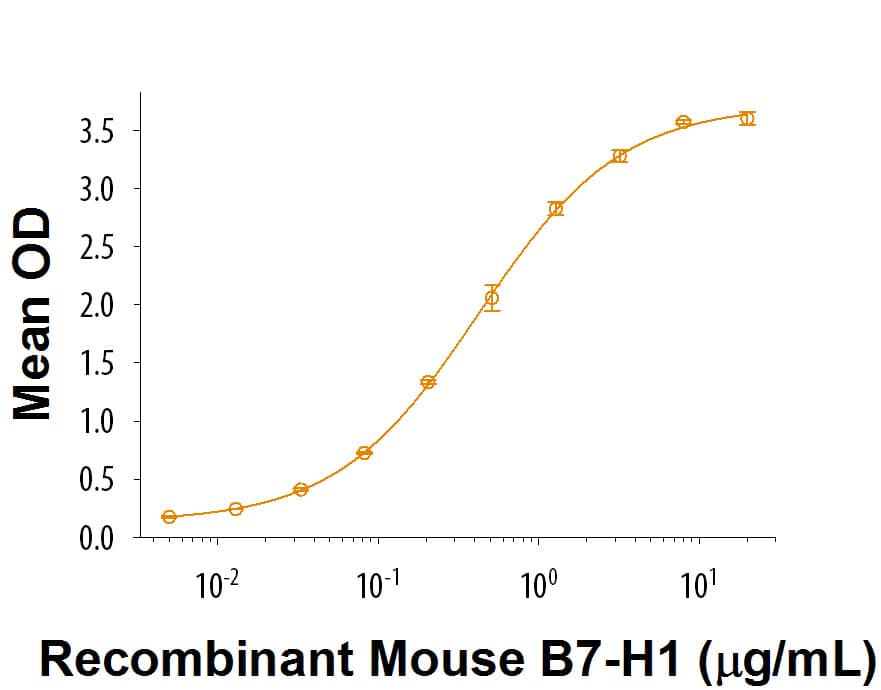Recombinant Mouse PD-1 Fc Chimera Protein, CF
R&D Systems, part of Bio-Techne | Catalog # 1021-PD

Key Product Details
Source
NS0
Accession #
Structure / Form
Disulfide-linked homodimer
Conjugate
Unconjugated
Applications
Binding Activity
Product Specifications
Source
Mouse myeloma cell line, NS0-derived mouse PD-1 protein
| Mouse PD-1 (Leu25-Gln167) Accession # Q02242 |
IEGRMD | Human IgG1 (Pro100-Lys330) |
| N-terminus | C-terminus |
Purity
>90%, by SDS-PAGE visualized with Silver Staining and quantitative densitometry by Coomassie® Blue Staining.
Endotoxin Level
<0.10 EU per 1 μg of the protein by the LAL method.
N-terminal Sequence Analysis
Leu25
Predicted Molecular Mass
43 kDa (monomer)
SDS-PAGE
66 kDa, reducing conditions
Activity
Measured by its binding ability in a functional ELISA.
Immobilized Recombinant Mouse PD-1 Fc Chimera at 1 µg/mL (100 µL/well) can bind Recombinant Mouse B7‑H1/PD‑L1 Fc Chimera (Catalog # 1019-B7) with an ED50 of 0.16-0.8 μg/mL.
Immobilized Recombinant Mouse PD-1 Fc Chimera at 1 µg/mL (100 µL/well) can bind Recombinant Mouse B7‑H1/PD‑L1 Fc Chimera (Catalog # 1019-B7) with an ED50 of 0.16-0.8 μg/mL.
Reviewed Applications
Read 4 reviews rated 5 using 1021-PD in the following applications:
Scientific Data Images for Recombinant Mouse PD-1 Fc Chimera Protein, CF
Recombinant Mouse PD-1 Fc Chimera Protein Bioactivity
When Recombinant Mouse PD-1 Fc Chimera (Catalog # 1021-PD) is coated at 1 µg/mL, Recombinant Mouse B7-H1/PD-L1 Fc Chimera (Catalog # 1019-B7) binds with an ED50 of 0.16-0.8 µg/mL.Formulation, Preparation and Storage
1021-PD
| Formulation | Lyophilized from a 0.2 μm filtered solution in Tris-HCL, NaCl and EDTA with Trehalose. |
| Reconstitution |
Reconstitute at 0.5 mg/mL in sterile water.
|
| Shipping | The product is shipped at ambient temperature. Upon receipt, store it immediately at the temperature recommended below. |
| Stability & Storage | Use a manual defrost freezer and avoid repeated freeze-thaw cycles.
|
Background: PD-1
co-inhibitory signals on T cells promoting their apoptosis, anergy, and functional exhaustion (10). Thus, the PD-1:PD-L1 interaction is a key regulator of the threshold of immune response and peripheral immune tolerance (11). Finally, blockade of the PD-1: PD-L1 interaction by either antibodies or genetic manipulation accelerates tumor eradication and shows potential for improving cancer immunotherapy (12, 13).
References
- Ishida, Y. et al. (1992) EMBO J. 11:3887.
- Sharpe, A.H. and G. J. Freeman (2002) Nat. Rev. Immunol. 2:116.
- Coyle, A. and J. Gutierrez-Ramos (2001) Nat. Immunol. 2:203.
- Nishimura, H. and T. Honjo (2001) Trends Immunol. 22:265.
- Watanabe, N et al. (2003) Nat. Immunol. 4:670.
- Zhang, X. et al. (2004) Immunity 20:337.
- Lázár-Molnár, E. et al. (2008) Proc. Natl. Acad. Sci. USA 105:10483.
- Nishimura, H et al. (1996) Int. Immunol. 8:773.
- Keir, M.E. et al. (2008) Annu. Rev. Immunol. 26:677.
- Butte, M.J. et al. (2007) Immunity 27:111.
- Okazaki, T. et al. (2013) Nat. Immunol. 14:1212.
- Iwai, Y. et al. (2002) Proc. Natl. Acad. Sci. USA 99: 12293.
- Nogrady, B. (2014) Nature 513:S10.
Long Name
Programmed Death-1
Alternate Names
CD279, PD1, PDCD1, SLEB2
Entrez Gene IDs
Gene Symbol
PDCD1
UniProt
Additional PD-1 Products
Product Documents for Recombinant Mouse PD-1 Fc Chimera Protein, CF
Product Specific Notices for Recombinant Mouse PD-1 Fc Chimera Protein, CF
For research use only
